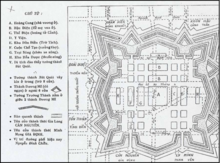Olivier de Puymanel
Victor Olivier de Puymanel | |
|---|---|
| Born | 1768 Carpentras, Kingdom of France |
| Died | 1799 Malacca, Malaysia |
| Allegiance | Vietnam |
| Service/ | French Navy |
| Battles/wars | Nha Trang, 1795 |

Victor Olivier de Puymanel (1768 in Carpentras – 1799 in Malacca), Nguyễn Văn Tín (阮文信) or Ông Tín[1] in Vietnamese,[2] was a French construction officer and a French Navy volunteer and adventurer who had an important role in Vietnam in the 18th and 19th century. He played a key role in the modernization of the army of Nguyễn Phúc Ánh (the future Emperor Gia Long).[3]
Olivier de Puymanel was second-class volunteer on board the French warship Dryade. In 1788 he deserted his ship while in Pulo Condor.[4] He soon entered into the service of the Vietnamese prince Nguyễn Phúc Ánh at the instigation of Pigneau de Behaine, who was setting up a force of French volunteers to help the latter regain the throne.[5]
Olivier de Puymanel supervised the construction of the Citadel of Saigon,[5] according to the design of the French engineer in Vietnam Théodore Lebrun.[6]

He also trained Vietnamese troops in the modern use of artillery, and implemented European infantry methods in the Vietnamese army of Nguyễn Phúc Ánh.[5] In 1792, Olivier de Puymanel was commanding an army of 600 men who had been trained with European techniques.[3]
Puymanel built a fortress in Duyên Khanh, near Nha Trang, where he defended the city against Tây Sơn forces, together with Pigneau de Behaine and Prince Cảnh.[3] In 1795, Puymanel engineered the campaign to take Nha Trang.[7]
Puymanel is said to have help organize train the men of Nguyen's army,[8] while Dayot was in charge of the Navy.[9] The results of these French efforts at the modernization of Vietnamese forces were attested by John Crawfurd, who visited Huế in 1822:
"In Cochin China a military organization has been established through the example and assistance of the French refugees in the country which has at least a very imposing appearance. The army consists of about forty thousand men uniformely clothed in British broad cloth, officered after the European manner and divided up into battalions under brigades. The park of artillery is numerous and excellent."
— Narrative of the Crawfurd mission....[10]
Olivier de Puymanel also worked on the cartography of the Vietnamese coast, together with Jean-Marie Dayot, another French officer in the service of Nguyễn Phúc Ánh.
Pigneau de Behaine and Puymanel seem to have disliked each other, and Pigneau was rather unimpressed with Puymanel's drinking habits and reliance on Saigon prostitutes.[11]
See also
[edit]
Notes
[edit]- ^ Ông Tín means Mr. Tín in Vietnamese.
- ^ East Asian Cultural Studies - Page 204 by Yunesuko Higashi Ajia Bunka Kenkyū Sentā (Tokyo, Japan) - East Asia - 1962: "Among those who participated in his venture, there were De Forcant (surnamed Le Văn Lang in Vietnamese), Olivier de Puymanel (Ong Tin), Philippe Vannier..."
- ^ a b c Mantienne, p.153
- ^ Mantienne, p.150
- ^ a b c The Vietnamese Response to French Intervention, 1862-1874 by Mark W. McLeod, p.11 [1]
- ^ Mantienne, p.151
- ^ Viet Nam: Borderless Histories - Page 204 by Nhung Tuyet Tran, Anthony Reid [2]
- ^ Colonialism By Melvin Eugene Page, Penny M. Sonnenburg, p.723
- ^ European warfare, 1660-1815 by Jeremy Black p.24: "Puymanel was responsible for the army, Jean Marie Dayot for the navy."
- ^ In Alastair Lamb The Mandarin Road to old Huế, p.251, quoted in Mantienne, p.153
- ^ Viet Nam: Borderless Histories - Page 204-205 by Nhung Tuyet Tran, Anthony Reid [3]
References
[edit]- Mantienne, Frédéric 1999 Monseigneur Pigneau de Béhaine, Editions Eglises d'Asie, 128 Rue du Bac, Paris, ISSN 1275-6865 ISBN 2-914402-20-1



